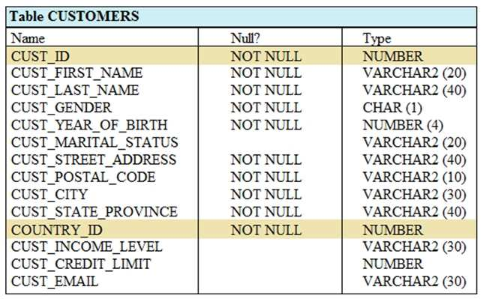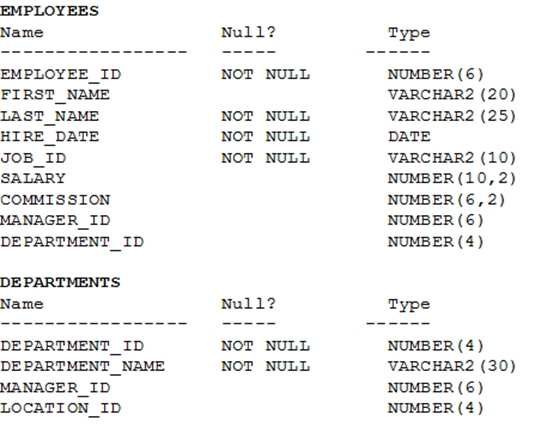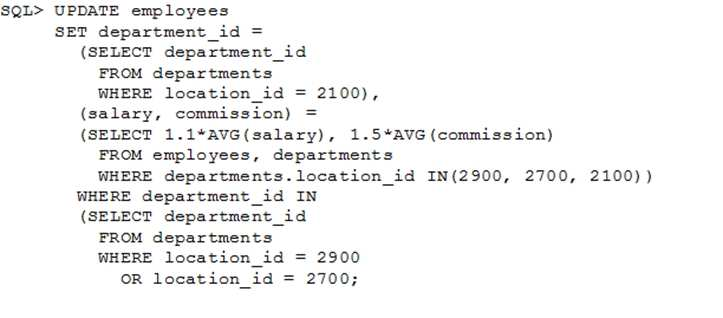File Info
| Exam | Oracle Datbase 12c SQL |
| Number | 1z0-071 |
| File Name | Oracle.1z0-071.ActualTests.2020-05-27.212q.vcex |
| Size | 11 MB |
| Posted | May 27, 2020 |
| Download | Oracle.1z0-071.ActualTests.2020-05-27.212q.vcex |
How to open VCEX & EXAM Files?
Files with VCEX & EXAM extensions can be opened by ProfExam Simulator.
Coupon: MASTEREXAM
With discount: 20%





Demo Questions
Question 1
Examine this statement:
Select cust_id, cust_last_name "Last name"
FROM customers
WHERE country_id = 10
UNION
SELECT cust_id CUST_NO, cust_last_name
FROM customers
WHERE country_id = 30
Identify three ORDER BY clauses any one of which can complete the query successfully.
- ORDER BY "Last name"
- ORDER BY 2, cust_id
- ORDER BY CUST_NO
- ORDER BY 2, 1
- ORDER BY "CUST_NO"
Correct answer: ABD
Explanation:
Using the ORDER BY Clause in Set Operations The ORDER BY clause can appear only once at the end of the compound query. Component queries cannot have individual ORDER BY clauses. The ORDER BY clause recognizes only the columns of the first SELECT query. By default, the first column of the first SELECT query is used to sort the output in an ascending order. Using the ORDER BY Clause in Set Operations
- The ORDER BY clause can appear only once at the end of the compound query.
- Component queries cannot have individual ORDER BY clauses.
- The ORDER BY clause recognizes only the columns of the first SELECT query.
- By default, the first column of the first SELECT query is used to sort the output in an ascending order.
Question 2
Which statement is true regarding external tables?
- The CREATE TABLE AS SELECT statement can be used to upload data into a normal table in the database from an external table.
- The data and metadata for an external table are stored outside the database.
- The default REJECT LIMIT for external tables is UNLIMITED.
- ORACLE_LOADER and ORACLE_DATAPUMP have exactly the same functionality when used with an external table.
Correct answer: A
Explanation:
References:https://docs.oracle.com/cd/B28359_01/server.111/b28310/tables013.htm References:
https://docs.oracle.com/cd/B28359_01/server.111/b28310/tables013.htm
Question 3
Which two statements are true regarding roles? (Choose two.)
- A role can be granted to itself.
- A role can be granted to PUBLIC.
- A user can be granted only one role at any point of time.
- The REVOKE command can be used to remove privileges but not roles from other users.
- Roles are named groups of related privileges that can be granted to users or other roles.
Correct answer: BE
Explanation:
References:http://docs.oracle.com/cd/E25054_01/network.1111/e16543/authorization.htm#autoId28 References:
http://docs.oracle.com/cd/E25054_01/network.1111/e16543/authorization.htm#autoId28
Question 4

Evaluate the following statement.

Which statement is true regarding the evaluation of rows returned by the subquery in the INSERT statement?
- They are evaluated by all the three WHEN clauses regardless of the results of the evaluation of any other WHEN clause.
- They are evaluated by the first WHEN clause. If the condition is true, then the row would be evaluated by the subsequent WHEN clauses.
- They are evaluated by the first WHEN clause. If the condition is false, then the row would be evaluated by the subsequent WHEN clauses.
- The insert statement would give an error because the ELSE clause is not present for support in case none of WHEN clauses are true.
Correct answer: A
Explanation:
References:http://psoug.org/definition/WHEN.htm References:
http://psoug.org/definition/WHEN.htm
Question 5
Examine the structure of the MEMBERS table:
Name Null? Type
------------------ --------------- ------------------------------
MEMBER_ID NOT NULL VARCHAR2 (6)
FIRST_NAME VARCHAR2 (50)
LAST_NAME NOT NULL VARCHAR2 (50)
ADDRESS VARCHAR2 (50)
You execute the SQL statement:
SQL > SELECT member_id, ' ' , first_name, ' ' , last_name "ID FIRSTNAME LASTNAME " FROM members;
What is the outcome?
- It fails because the alias name specified after the column names is invalid.
- It fails because the space specified in single quotation marks after the first two column names is invalid.
- It executes successfully and displays the column details in a single column with only the alias column heading.
- It executes successfully and displays the column details in three separate columns and replaces only the last column heading with the alias.
Correct answer: D
Question 6
You issue the following command to drop the PRODUCTS table:
SQL > DROP TABLE products;
Which three statements are true about the implication of this command? (Choose three.)
- All data along with the table structure is deleted.
- A pending transaction in the session is committed.
- All indexes on the table remain but they are invalidated.
- All views and synonyms on the table remain but they are invalidated.
- All data in the table is deleted but the table structure remains.
Correct answer: ABD
Question 7

View the Exhibit and examine the structure of CUSTOMERS table.
Using the CUSTOMERS table, you need to generate a report that shows an increase in the credit limit by 15% for all customers. Customers whose credit limit has not been entered should have the message "Not Available" displayed.
Which SQL statement would produce the required result?

- SELECT NVL (TO CHAR(cust_credit_limit * .15), 'Not Available') "NEW CREDIT"FROM customers;
- SELECT TO_CHAR (NVL(cust_credit_limit * .15), 'Not Available') "NEW CREDIT"FROM customers;
- SELECT NVL(cust_credit_limit * .15), 'Not Available') "NEW CREDIT"FROM customers;
- SELECT NVL(cust_credit_limit), 'Not Available') "NEW CREDIT"FROM customers;
Correct answer: A
Question 8


View the exhibit and examine the structures of the EMPLOYEES and DEPARTMENTS tables.

You want to update EMPLOYEES table as follows:
- Update only those employees who work in Boston or Seattle (locations 2900 and 2700).
- Set department_id for these employees to the department_id corresponding to London (location_id 2100).
- Set the employees' salary in location_id 2100 to 1.1 times the average salary of their department.
- Set the employees' commission in location_id 2100 to 1.5 times the average commission of their department.
You issue the following command:

What is outcome?
- It generates an error because multiple columns (SALARY, COMMISSION) cannot be specified together in an UPDATE statement.
- It generates an error because a subquery cannot have a join condition in a UPDATE statement.
- It executes successfully and gives the desired update
- It executes successfully but does not give the desired update
Correct answer: D
Question 9

Evaluate the following two queries:

Which statement is true regarding the above two queries?
- Performance would improve in query 2 only if there are null values in the CUST_CREDIT_LIMIT column.
- There would be no change in performance.
- Performance would degrade in query 2.
- Performance would improve in query 2.
Correct answer: B
Question 10
Examine the business rule:
Each student can work on multiple projects and each project can have multiple students.
You must design an Entity Relationship (ER) model for optimal data storage and allow for generating reports in this format:
STUDENT_ID FIRST_NAME LAST_NAME PROJECT_ID PROJECT_NAME PROJECT_TASK
Which two statements are true? (Choose two.)
- The ER must have a 1-to-many relationship between the STUDENTS and PROJECTS entities.
- The ER must have a many-to-many relationship between the STUDENTS and PROJECTS entities that must be resolved into 1-to-many relationships.
- STUDENT_ID must be the primary key in the STUDENTS entity and foreign key in the PROJECTS entity.
- PROJECT_ID must be the primary key in the PROJECTS entity and foreign key in the STUDENTS entity.
- An associative table must be created with a composite key of STUDENT_ID and PROJECT_ID, which is the foreign key linked to the STUDENTS and PROJECTS entities.
Correct answer: BE
Explanation:
References:http://www.oracle.com/technetwork/issue-archive/2011/11-nov/o61sql-512018.html References:
http://www.oracle.com/technetwork/issue-archive/2011/11-nov/o61sql-512018.html

